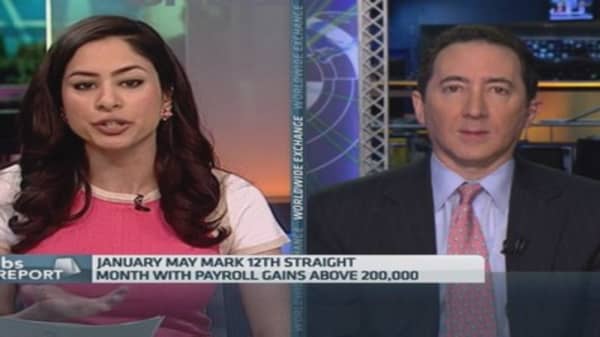Ignoring the possibility that this might have been a year-end technical adjustment to accommodate the banking system – already awash in a mind-boggling pool of $2.6 trillion in excess reserves – one must look for reasons in the usual set of factors, consisting of the policy mix, labor market conditions, economic activity and the dollar's trading on global currency markets.
Labor market and a strong dollar
Those of you who might think that this is a wild goose chase should recall that this is the analytic process that provides the policy input to FOMC (the Fed's interest-rate setting committee) decisions.
So, let's start with the policy mix.
America's progress on fiscal consolidation since 2009 is quite impressive. Since that time, the general government budget deficit has been more than cut in half to reach an estimated 5.1 percent of the gross domestic product (GDP) in 2014. In the current fiscal year, that payment gap is projected to narrow to about 4 percent of GDP, mainly as a result of an expected revenue increase.
Technically, therefore, the U.S. fiscal stance remains restrictive. Looming election year gridlocks are preventing the much needed public infrastructure investments, leaving the policy focus firmly on the prospect of ballooning costs of healthcare and entitlement programs for an aging population.
Read MoreJack Welch: Fed would be 'insane' to hike rates
Clearly, then, there is a case for an accommodating monetary policy to help stabilize the economy around its potential growth path. But that is what the Fed was doing already, and I don't think that a more balanced policy mix needed any additional monetary support.
America's bubbly bond markets seem to share that view. Last Friday's 14-basis-point increase in the yield on the benchmark ten-year Treasury note was a loud response to the broad-based creation of 257,000 new jobs in the course of January.
The Fed will probably take that as a bond market over-reaction since the actual unemployment rate (taking into account involuntary part-time workers and people who dropped out of the labor force because they were unable to find a job) is exactly double the officially reported 5.7 percent. On top of that, no progress was noted on the number of the long-term unemployed; at 2.8 million they still represent almost one-third of the jobless total.
That is a large labor market slack. With subdued wages and prices, it is no wonder why employment creation has become a major concern in the exercise of the Fed's policy mandate.
A broader issue for the Fed is what the current employment picture holds for the medium-term growth outlook of the U.S. economy.
That's where jobs and incomes, along with low credit costs, play a key role. Looking at the latest GDP numbers, the Fed may find some reasons to worry.
For example, in spite of cheap credit and a reviving bank and nonbank consumer lending, household expenditures and residential investments – nearly three-quarters of the U.S. economy – were a weaker source of growth last year compared with 2013. Indeed, while the growth of consumer outlays was roughly the same, the housing sector turned in a dismal 1.7 percent increase compared with the previous year's booming 12 percent gain.
Call out the free riders
These two interest-sensitive components of aggregate demand are closely correlated because residential purchases drive most of consumption spending and related building trades. If this key engine of U.S. growth nearly stalled last year in spite of record-low credit costs, the Fed probably fears what could happen if interest rates were pushed up by large liquidity withdrawals.
The strong dollar – signaling the greenback's excess demand in world currency markets -- is another issue. Over the last twelve months, the dollar's trade-weighted exchange rate soared 15 percent, and, given what is happening in Europe, there is every reason to believe that the trend will continue.
The upshot is that the growing U.S. economy and a rising dollar widened the gap on goods trade in the first 11 months of last year by 3.4 percent. America's biggest trade deficits were run with China ($314.3 billion), Germany ($67.4 billion) and Japan ($61.3 billion).
And that did some damage. The preliminary data show that the trade deficit cut the U.S. GDP growth last year by 0.2 percent. I believe that the negative growth impact of net exports will be much larger once the definite trade numbers for the fourth quarter are known.
Investment thoughts
Bond traders yelling at the Fed to stay away from interest rate hikes are knocking on an open door. The Fed is obliging; it continues to act as the world's lender of last resort amid a soaring dollar and Europe's dimming recovery aggravated by the region's intractable political and economic chaos.
President Obama's trade diplomats and financial officers should take to task the Asian and European free riders at today's G-20 meeting in Istanbul, Turkey. And so should the IMF. The president will also have a chance to do some of that during today's visit of Germany's Chancellor Angela Merkel – if he can get over a largely useless pursuit of trying to use Germany in order to punish and isolate Russia.
So, don't yell at the Fed. It is the only institution holding the world economy together.
Michael Ivanovitch is president of MSI Global, a New York-based economic research company. He also served as a senior economist at the OECD in Paris, international economist at the Federal Reserve Bank of New York and taught economics at Columbia.





